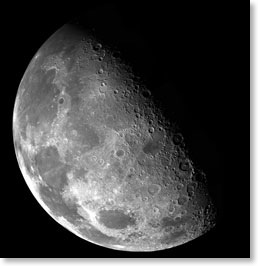Have Scientists Discovered the Origin of the Moon?
Scientists have devised four major theories for the moon's beginning.
- The fission theory states that the moon long ago split off from the spinning earth, like mud flung from a bicycle wheel. Some say that the Pacific Ocean basin is the scar that remains from this loss of material. There are four distinct remains from this loss of material. There are four distinct problems with this theory. First, today's earth and moon do not have nearly enough circular motion for fission to ever have occurred. Second, although a moon splitting off from the earth would be expected to orbit directly above the equator, in actuality the moon's orbit is always tilted between 18 and 28 to the earth's equator. This is the reason why the moon appears higher or lower in the sky during different seasons. Third, while the fissioned moon was moving outward from the earth, gravity would have pulverized it into Saturn-type rings. Fourth, moon rocks are chemically different from the equivalent material on Earth. It does no appear that the moon came from the earth.
- According to the capture theory, gravity brought the moon into permanent earth orbit when it once wandered too close to Earth. The main problem in this theory is the low probability that two large space objects would pass each other so closely. Another problem involves the actual "capture" mechanism-it simply wouldn't happen! Instead, the moon would continue on its journey. We have often sent space probe "fly-bys" to other planets and they are not captured but instead are thrown outward with great speed, as in a crack-the-whip game. Finally, capture doesn't really qualify as an origin theory since it assumes the moon's prior existence.
- The third theory has several names: condensation, nebular contraction, or accretion. It proposes the concurrent formation of both the earth and moon from clouds of space material. As a result, the new moon "just happens" to circle the earth. The main assumption here is that space material will actually fall together into a big lump due to gravity. Force calculations rule out such a collapse unless the cloud of material is already quite dense. Present-day dust clouds observed in space are rarely this dense, and most are spreading outward.
- The fourth lunar-origin theory, very popular today, calls for a collision between the early earth and another large planetary object. The impact resulted in an orbiting cloud of debris that eventually grouped itself into the moon. Some critics of this theory believe that such a giant impact would totally melt the earth's crust. Others question the probability of another object hitting the earth with the precise speed and direction needed to result in the formation or the moon. Some computer models show that such a collision would result in two earth moons rather that just one, or even a Saturn-type ring. The main reason for promoting the collision idea appears to be that none of the other lunar-origin theories work.

The Bible and Astronomy
written by Dr. Donald DeYoung.